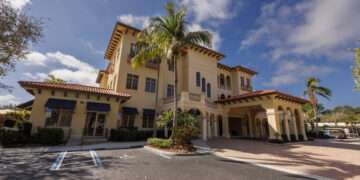You’ve been there. Stuck. On U.S. 41. On I-75. On Colonial Boulevard in Fort Myers. On Pine Ridge Road in Naples. On Corkscrew Road in Estero. Driving to and from Cape Coral and Lehigh Acres. In this state of “stuckness,” you scold yourself. Why didn’t you check traffic before leaving? Why haven’t you downloaded that traffic app yet to your phone? Why did you take this road? Where else would you go? Why do you live in a state where so many other people want to be? You know why, you like it too, but you’re late, frustrated and planning on speeding once things start moving.
“Take that that five minutes and multiply it twice a day, how many hours of life have just gone by because you’re stuck in traffic?” says Wayne Daltry, who spent 27 years with Southwest Florida Regional Planning Council before retiring. “Traffic is no little thing and then it goes to pot and then people start leaving because it’s not a good place to live. If you say, ‘People always come to Florida because it’s warm.’ Well, so is hell.”
And sometimes gridlock can feel that way.
EAST COAST TRAFFIC?
FIRST, LET’S BE CLEAR. Southwest Florida’s traffic might feel more like Florida’s East Coast but this region is far from being as congested as there. “A lot of people talk about trying not to be like the East Coast,” says Don Scott, Lee County Metropolitan Planning Organization (MPO) executive director. “I’m not sure we’ll be at that level in the future and it doesn’t show like that. There are parts of the system that obviously will have a lot more volume.”
In Lee and Collier counties, there is congestion in east-west corridors related to affordable housing stock and growth. People can live more cheaply in communities east of the interstate, like Lehigh Acres and Golden Gate, but drive west for work and play in Fort Myers and Naples. Some relief is on the way: Several projects are planned for the widening of SR 82, which connects Lehigh to Fort Myers and the interstate. Construction has already begun on a $63.6 million project to widen the road from two to six lanes from Lee Boulevard to Shawnee Road, according to the Lee MPO. Collier County is looking for ways to ease congestion on Pine Ridge Road, one of only four major Collier east-west corridors, Collier MPO’s executive director Anne McLaughlin says, noting that solutions for other east-west corridors are under design.
Yet, road infrastructure can only grow so much due to environmental concerns and constraints from established neighborhoods, Scott says. Reasons like that factor in to why an additional bridge can’t be built from Cape Coral. “Years ago, there were other plans for a bridge but because of environmental issues, it would be very hard and very expensive.” Cape bridges, particularly in the mornings and evenings with commuter drivers, are not places you want to be and “it seems like it’s gotten worse in the last couple of weeks,” he says.
Gridlock may hurt more now because you had a break during the recession years. In 2011, Collier County traffic dipped to an average of 8.7 million daily miles driven, according to Florida Department of Transportation’s average annual daily traffic counts. Lee hit about 17.7 million. Both figures were lower than traffic counts a few years earlier, in 2007, unlike the current trend toward sustained traffic growth. “It’s not a dramatic change,” says McLaughlin. “It’s a steady increase in traffic and growth since recovery from the recession.”
In 2016, Lee counted nearly 21 million miles driven a day. Collier was at about 10 million. By comparison, Miami-Dade’s figure reached nearly 55 million.
Still, that doesn’t mean the next months will be easy. What’s McLaughlin’s prediction for season? She stifles a chuckle as she utters the inevitable. “Lots of traffic.”
COULD A COMMUTER RAIL BE MORE THAN A DREAM?
AS YOU DRIVE AROUND Southwest Florida, there are holes where some of your favorite swaths of trees used to be. Homes and condos are planned. These changes, you know, are a condition of living in Florida, but it’s been a stretch since you’ve seen a boom like this. “They’re going like gangbusters in Collier and in Charlotte and in Lee and there’s no end in sight. It’s back,” says Bill Spikowski, a Fort Myers-based planner who works throughout Florida. “And construction kicks off whole orgy of activity, much of which involves people getting into their cars.”
A central gridlock-inducing problem is: there’s not capacity to construct more north-south corridors, he says. “We know from the go-go years that the problem is there and there’s really not a way to build north-south streets.”
For years, he’s been pushing for a commuter rail to be added to an existing railroad line between Fort Myers and Bonita Springs that could connect to North Naples through public transit. “It’s the solution that will most likely help.”
He was on the team for the 2013 rail corridor feasibility study for the Lee County MPO. Nearly 18,000 Lee County residents commute to Collier County while about 9,000 make the trek from Collier to Lee, according to Census estimates. Plans of the past encouraged consolidated development to promote fewer cars and time on the road. Sprawl endures and commute times get longer.
“With all the people who live in Lee County and work in Collier and now get on the interstate, if you could get even a fifth of them riding public transportation, it would be a really good thing.”
Bonita Springs, Fort Myers and Estero have amended their comprehensive plans to support a commuter rail, he says, noting that next steps would be for Lee County to follow suit and the Florida Department of Transportation to acquire the right-of-way. “It’s a decade out, optimistically.”
Commute times for workers and the cost of employees being stuck in traffic are definite concerns for employers with a regional workforce, says Eric. E. Berglund, president of the Southwest Florida Economic Development Alliance.
“When companies look at places to grow and expand to, transportation is critically important.” How company leaders view Southwest Florida’s traffic depends largely on their experiences. “If it is somebody that is used to Los Angeles, Boston, New York, Miami, they come over here and say ‘there’s no traffic here at all,’” Berglund says. But that doesn’t mean there’s no need for improvements. Which brings you to the interstate.
NEW MASTER PLAN FOR I-75
THERE’S THAT MOMENT WHEN you drive your car toward the interchange and spot gridlock. “Oh dang,” you say. Or worse, perhaps, because you are in the privacy of the car.
Your schedule for this evening goes out the window. The kids will be late to practice. You’ll miss 20 minutes of pottery class. Dinner will be a rushed affair.
The good news: There are plans and projects on deck that will likely improve traffic flows in and around I-75 in Lee and Collier counties. There’s a joint focus on locating and clearing crashes quickly. The goal is to have a scene cleared within 90 minutes, says FDOT, which has also been installing larger signs at interchanges to try to prevent wrong-way driving on the interstate.
FDOT has committed to a $3 million new master plan for the entire interstate in Lee and Collier counties to determine what improvements might be needed in the future and ultimately develop a plan to fund those improvements, says Zac Burch, FDOT spokesman. The last master plan done for that area was 1998. The new study is set to begin in fiscal year 2018/2019.
Major interchange improvements slated for the near future in Lee and Collier counties are expected to noticeably improve congestion. FDOT will be “completely restructuring” interchanges at Colonial Boulevard in Lee and S.R. 951, or Collier Boulevard, in Collier County. The Colonial interchange project, estimated at more than $52 million, will include a fairly new design concept called the “diverging diamond interchange.” The project is slated to begin construction in the fiscal year starting in 2019. The design’s intent is to improve traffic flow and reduce congestion by accommodating left-turning movements and eliminating the need for left-turn bays and signal phases at signalized ramps.
“FDOT recently completed the first diverging diamond interchange in Florida at University Parkway in Sarasota and it has done an amazing job at reducing congestion and wait times at that very busy interchange,” Burch says.
FDOT expects to complete design plans for the Collier Boulevard interchange in 2020 and offers this description of the project: “The new interchange will include two new ramps over S.R. 84 [Davis Boulevard] to provide direct interstate access… New bridges to accommodate ramp traffic will be constructed adjacent to the existing I-75 bridges over S.R. 951.”
McLaughlin, Collier MPO executive director, expects big returns from the $100 million-plus project in terms of reducing congestion. “That should have a substantial impact right at that point.”
In Estero, at the Corkscrew Road interchange, there are plans to reduce back-ups that are aggravating drivers and creating safety concerns.
“The left-turn lanes are pretty long for the amount of traffic that wants to go on the interstate, either north or south, especially in the morning and evening rush hour, so you have cars fill up the whole turn lane and blocking up the lane,” Burch says. “It creates a situation where the interchange is not really working.”
FDOT considered building a new interchange, but identified a project that could be done sooner with left- turn lanes, which Burch says are the biggest gridlock factors in that segment. “The solution is to make those left-turn lanes double left-turn lanes.”
The project is funded for the fiscal year beginning next year. It should create “an acceptable level of service for at least 10 years,” Burch says but if growth accelerates more than they anticipate the agency will try to accelerate improvements too.
“That interchange is going to have to be built out at some point.”
 EAST ESTERO BOOM
EAST ESTERO BOOM
CORKSCREW ROAD, EAST OF the interstate in Estero, is far from desolate, though it once was a rural stretch that reminded you of how Southwest Florida could look: wild.
“I think Corkscrew Road, east of I-75, which is only two lanes, is bearing the brunt of the large number of developments out east and a large volume of sand trucks coming from the mines out east,” says Howard Levitan, Estero village councilman. “We’re working to try to solve that problem.”
The number of planned units is jaw dropping. Bob King, transportation director for the Estero Council of Community Leaders, has tallied them up. There are about 5,000 units already on Corkscrew Road, east of the interstate from Ben Hill Griffin Parkway to Corkscrew Shores development next to Bella Terra, and about 5,000 more in the works along east Corkscrew, he says. There are already problems.
“For the neighbors who live on the south side, when you need to leave the community and go west, making a left turn is a dangerous situation,” King says. “What the residents would like to see is the infrastructure improved before the new building is approved but there’s no funding to do infrastructure.”
Part of the problem, advocates for sustainable planning say, is that Lee County is not collecting millions of dollars that it could be in impact fees, or one-time charges on new development to help defray costs for new or expanded infrastructure. During the recession years, Lee commissioners offered a blanket reduction. Collier County, on the other, never reduced its impact fees by policy but it ended up being reduced based on factors used in the county’s methodology during recession. Now, however as costs are on the rise, the fees are an upward trend though not yet to the construction boom years before the recession, says Amy Patterson, director of capital projects and planning for the Collier County growth management.
Lee County lost a total of $77 million, including $30 million for roads, over more than four years due to the Lee County commission’s impact fee reduction policies, according to a September 2017 analysis by Darla Letourneau, of Lee Public Voice, who regularly analyzes the impact of the commission’s decision using county data.
Since reducing impact fees in 2013, Lee commissioners have not fully restored them. The fees sit at 45 percent, which Daltry says provides for “way below” the cost of infrastructure needs. “You just end up with empty pockets with lots of needs.”
His prognosis is bleak. But must you, the driver, have to accept getting stuck in traffic as the new normal? “If you accept it, you accept that the property values are about to drop,” Daltry says. “Vote against everybody who says we can do it better with less money… They’re giving our quality of life away.”
King, too, suggests doing something. “The problem is if everyone sits around in the living room and watches TV and they don’t get involved and then they look around one day and find out their roads are so clogged they can hardly use them.”
Some relief is on the way in the coming years but without millions of dollars in infrastructure investments, paired with forward-thinking leaders who look for ways to consolidate development and get more people off the roads, you will get stuck more often. See you in the slow lane.





